It’s All About FEC: Like a Box of Chocolates
By Brady S. Volpe and Mike Collins
We have all heard the stories of how well DOCSIS 3.1 is working. Perhaps your system has been involved in one of these stories too. One thing is true, DOCSIS 3.1 is working really well — even better than we had anticipated. Here is why DOCSIS 3.1 is working really well — it is all about forward error correction (FEC). [For the purpose of this article we will only discuss error correction in the downstream]
Reed Solomon forward error correction (RS-FEC) has been used in all previous generations of DOCSIS. I’ve previously covered RS-FEC and how it works here (https://volpefirm.com/docsis-codeword-errors/). RS-FEC has served DOCSIS very well, but advances in silicon technology enable us to take advantage of more powerful error correction techniques now, which provide significantly better data transmission robustness.
DOCSIS 3.1 has a major update in forward error correction moving from RS-FEC to a concatenated Bose, Ray-Chaudhuri, Hocquenghem (BCH) and low-density parity check (LDPC) or for short, BCH-LDPC FEC. Try saying that 10 times really fast.
BCH is an outer encoding and LDPC is an inner encoding. This means that the CMTS encodes the data to be sent with BCH FEC first and then a second layer of protection using LDPC FEC. When the cable modem receives the data frame it has to first decode the LDPC and then the BCH. Let’s think of this as a box of chocolates, where BCH is the small foil wrapper around each individual chocolate and LDPC is the box protecting all of the chocolates inside. Together BCH and LDPC are providing two layers of protection around our data frame (the chocolates). Most importantly we just want to make sure that the chocolates are okay before we eat them, or the data frame is okay before we pass it on. For example, if something is wrong and the box (the LDPC codeword) is crushed, we would assume the chocolates inside could be damaged also. However, due to BCH the data frame could still be intact or recoverable. Once we open the box we see the BCH as the foil wrappers protecting the chocolates. If the BCH is okay, then the chocolates are okay. If the BCH is bad, then we have bad chocolates and an uncorrectable codeword error.
Currently we are collecting field data, and technicians are seeing correctable and uncorrectable codewords coming from LDPC and BCH FEC in DOCSIS 3.1 modems or field meters. However, an interesting phenomenon has occurred where it is very common to see up to 100% correctable LDPC codeword errors and zero uncorrectable BCH codeword errors. In a pre-DOCSIS 3.1 Reed-Solomon FEC environment this would be a big concern, because having so many correctable codeword errors is usually an indicator that uncorrectable codeword errors are immediately upon us. Not so in DOCSIS 3.1. In fact, it is very common to have up to 100% correctable LDPC codeword errors with zero uncorrectable BCH codeword errors. This is because LDPC is quite good at fixing errors and we see the accumulation of errors. In the box of chocolates analogy, consider the box to be very resilient, as is LDPC.
Once the cable modem is done decoding LDPC it moves on to BCH — our wrapper on the chocolate. If the final wrapper is good, we get no uncorrectable codeword errors. If there are problems, then we get uncorrectable errors. It is the uncorrectable codeword errors that we must concern ourselves with as these are subscriber impacting. Again, let’s reinforce: in DOCSIS 3.1 it’s okay to have very high levels of correctable codeword errors as long as uncorrectable codewords are non-existent or less than 1%. Once uncorrectable codeword errors increase the CMTS should reduce the modulation order.
Real-World Data
Let’s look at some real-world data to better help illustrate these points.
First let’s understand the test setup as shown in Figure 1:
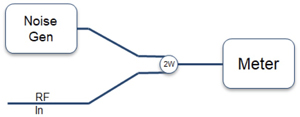
Now let’s look at Figure 2.
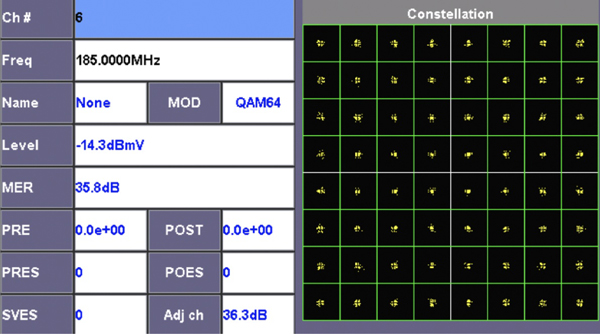
SC-QAM with no Pre or Post Errors
Next, we move to Figure 3.
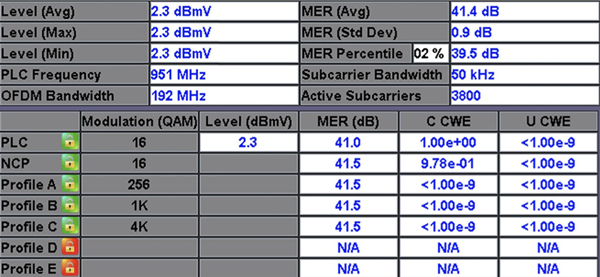
OFDM Channel with no Pre and Post Errors at 41.5 dB MER
Figure 4 shows what happens when we inject noise from the test setup noise generator in order to simulate an RF impairment such as LTE interference.
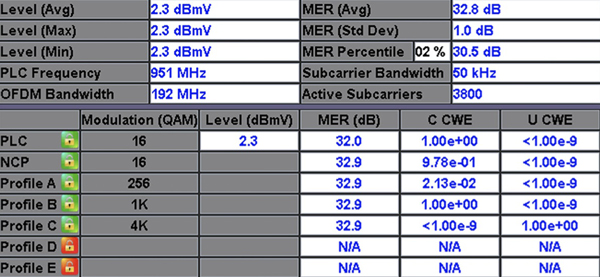
OFDM Channel with Pre and Post Errors at 41.5 dB MER
Looking at the 1024-QAM (aka 1k QAM) profile we see that C CWE (correctables) are at 100%, while U CWE (uncorrectables) are basically at zero. This means most traffic is flowing over the 1k QAM profile. As mentioned previously it is okay to have very high correctable codewords, in this case 100% correctable codewords, as the resulting uncorrectable codewords are at zero (<1.00e-9).
Profile A (256-QAM) is showing pretty high levels of correctables (C CWE) as well, but zero uncorrectables. We can see similar events for the next codeword pointer (NCP) and the PHY link channel (PLC) profiles, which are both running at 16-QAM. Both experience minor correctable codeword errors, but never experience uncorrectable codeword errors until the MER is dropped to 14 dB (not shown in this article due to page constraints).
Summary
First, we can no longer use correctable codeword errors as a leading indicator of uncorrectable errors in DOCSIS 3.1. Correctable codeword errors are still valid on any SC-QAM channel.
Second, uncorrectable codeword errors are still one of the most valuable indicators of an impaired signal. Uncorrectable codeword errors will always tell you if the data going to a subscriber is being negatively impacted. If you see uncorrectable codeword errors this means that the cable modem is not able to repair the corrupted data and is then also discarding the data. If the data can be re-transmitted, as an email, the cable modem will ask the remote server to resend. If the data is voice packets, then it’s keys in lava. Man, they are just gone.
Third, MER is a very good leading indicator in DOCSIS 3.1. In the accompanying figures, 2% MER values were displayed out of 4000 subcarriers. This means that the worst 2% of the individual MER measurements per subcarrier were displayed. However, we do not know which subcarriers they were. An even better measurement is MER per subcarrier which I provided an example of in my previous article in Broadband Library— https://broadbandlibrary.com/docsis-3-1-test/.
In conclusion there are some very important takeaways in test and measurement in DOCSIS 3.1 as discussed in this article. The future with DOCSIS 3.1 is very exciting.
Brady Volpe is Founder of The Volpe Firm, Inc and Nimble This LLC. He has over 25 years of broadband cable and telecommunications industry experience specializing in RF, DOCSIS, PNM, and Internet Protocol. Mr. Volpe has been providing a wide range of troubleshooting, design solutions, services and seminars for cable operators and broadband companies specializing in DOCSIS, System Design, PNM, and Troubleshooting. He is a highly respected published speaker, both domestically and internationally. He also hosts a popular industry Video / Podcast – “Get Your Tech On“. Mr. Volpe holds a BSEE and a MSEE.

Mike Collins
Product Manager,
VeEX Inc.
Mike Collins is a Product Manager with VeEX Inc. specializing in DOCSIS and sweep technologies. Mike has 25+ years in the cable industry, he’s an expert in the test and measurements field, including sweep, spectrum analysis and QAM/SLM measurements.
Credit:



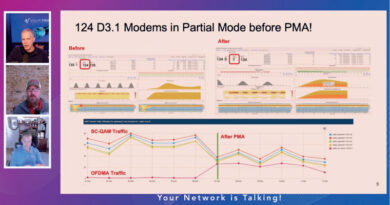
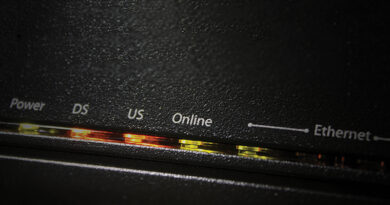
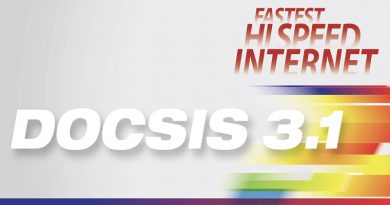
Pingback: It’s All About FEC in DOCSIS 3.1 | Like a Box of Chocolates with some RS